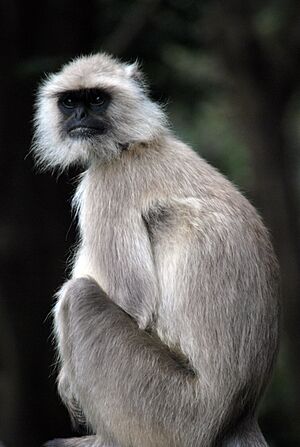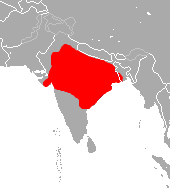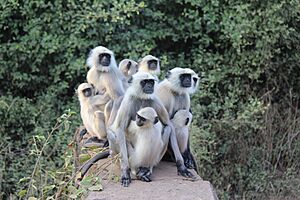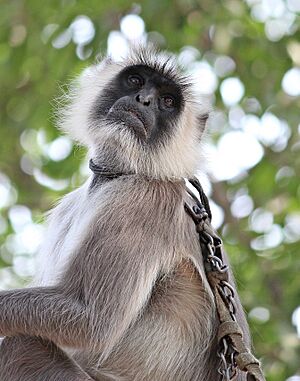Northern plains gray langur facts for kids
Quick facts for kids Northern plains gray langur |
|
|---|---|
 |
|
| Conservation status | |
| Scientific classification | |
| Genus: |
Semnopithecus
|
| Species: |
entellus
|
 |
|
| Northern plains gray langur range | |
The northern plains gray langur (Semnopithecus entellus), also known as the sacred langur or Hanuman langur, is a type of primate found in India. It belongs to the Cercopithecidae family, which includes many Old World monkeys. These langurs are often seen near human settlements and are considered special in the Hindu religion.
Contents
What is the Northern Plains Gray Langur?
The northern plains gray langur is a species of monkey. It is part of the Semnopithecus group, which includes other langurs found in India. Sometimes, people call it the sacred langur or Hanuman langur. This is because it is important in the Hindu religion.
Appearance of the Northern Plains Gray Langur
Adult northern plains gray langurs have mostly light-colored fur. Their backs and limbs have darker fur. Their faces, ears, hands, and feet are all black. Baby langurs are born brown.
These langurs can be quite large. Their bodies, not including their tails, are about 45.1 cm (17.8 in) to 78.4 cm (30.9 in) long. Their tails are even longer, measuring between 80.3 cm (31.6 in) and 111.8 cm (44.0 in).
Male langurs are heavier than females. Adult males weigh about 16.9 kg (37 lb) to 19.5 kg (43 lb). Adult females weigh between 9.5 kg (21 lb) and 16.1 kg (35 lb).
Where Do Northern Plains Gray Langurs Live?
The northern plains gray langur lives in a large part of India. You can find them south of the Himalayas. Their range goes down to the Tapti River and the Krishna River.
They are also thought to have been brought to western Bangladesh. This happened because Hindu pilgrims traveled there.
Daily Life and Habits of Langurs
Northern plains gray langurs are active during the day. They spend time both on the ground and in trees. Their natural homes are dry forests and dry shrublands.
Female langurs often groom, or clean, other langurs, both males and females. However, males usually do not groom others.
Langur Social Groups
Northern plains gray langurs live in different types of groups. Some groups have many males and females. Others have one male with many females. There can also be groups of many males with no females. Some males even live alone.
Groups with one male and many females are the most common. A group can have more than 100 monkeys! When young males grow up, they usually leave their birth group. Females, however, usually stay. Younger adult females often become leaders over older females.
When a new male takes over a group, he might sometimes harm the young babies. This happens less often if the takeover is slow.
What Do Langurs Eat?
Northern plains gray langurs mainly eat fruits and leaves. They can survive by eating mature leaves. This helps them find food even during the dry season. They also eat seeds, flowers, buds, bark, and insects like caterpillars.
Sometimes, people give them fruits and vegetables. Langurs living near temples often get a lot of food from people. They might also raid crops from farms.
Langur Reproduction and Life Cycle
Langurs that have plenty of food all year, like those near temples, can have babies any time. Groups living in forests usually give birth between December and May.
A mother langur is pregnant for about 200 days. For the first month, other female langurs help care for the baby. This is called alloparenting. Babies stop drinking milk at about 1 year old. Males become adults when they are about 6 to 7 years old.
Langurs and Other Animals
Northern plains gray langurs often hang out with chital deer. Both animals listen to each other's warning calls. The deer seem to benefit from the langurs watching for danger from the trees. The langurs benefit from the deer's good sense of smell and hearing. Langurs have also been seen grooming rhesus macaques.
Protecting the Northern Plains Gray Langur
The northern plains gray langur is listed as "least concern" by the IUCN Red List. This means they are not currently in great danger of disappearing. However, they are still threatened by habitat loss, which is when their natural homes are destroyed.
These langurs can live in many different places, even in towns and cities. The Hindu religion considers them sacred, which helps protect them. Because of this, they have a large population in India.
Still, they face some dangers. These include getting hit by cars, being attacked by dogs, forest fires, and diseases from farm animals. Sometimes, people hunt them for food, especially in certain states. They are also sometimes killed if they raid crops.
In Delhi, trained gray langurs are sometimes used to scare away rhesus macaques. Rhesus macaques can steal from people and sometimes attack them.






